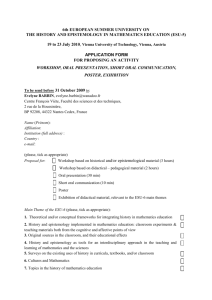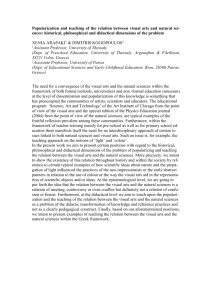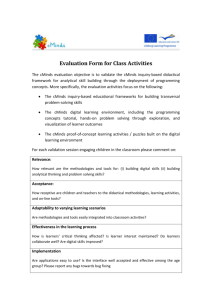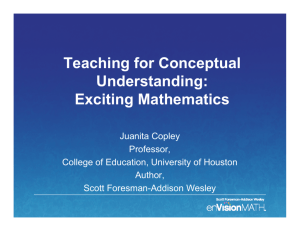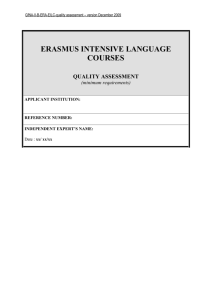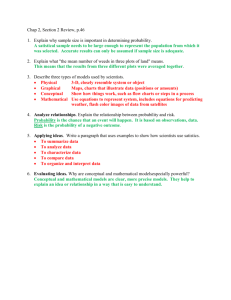DIDACTICAL KNOWLEDGE DEVELOPMENT OF PRE-SERVICE SECONDARY MATHEMATICS TEACHERS
advertisement
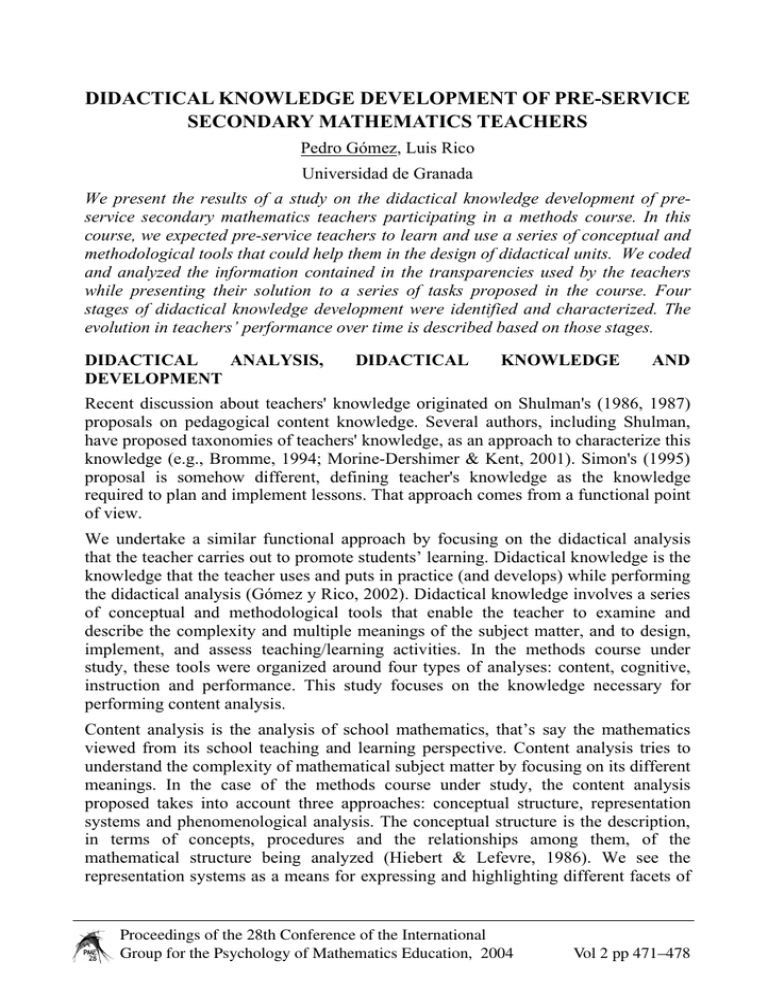
DIDACTICAL KNOWLEDGE DEVELOPMENT OF PRE-SERVICE SECONDARY MATHEMATICS TEACHERS Pedro Gómez, Luis Rico Universidad de Granada We present the results of a study on the didactical knowledge development of preservice secondary mathematics teachers participating in a methods course. In this course, we expected pre-service teachers to learn and use a series of conceptual and methodological tools that could help them in the design of didactical units. We coded and analyzed the information contained in the transparencies used by the teachers while presenting their solution to a series of tasks proposed in the course. Four stages of didactical knowledge development were identified and characterized. The evolution in teachers’ performance over time is described based on those stages. DIDACTICAL ANALYSIS, DEVELOPMENT DIDACTICAL KNOWLEDGE AND Recent discussion about teachers' knowledge originated on Shulman's (1986, 1987) proposals on pedagogical content knowledge. Several authors, including Shulman, have proposed taxonomies of teachers' knowledge, as an approach to characterize this knowledge (e.g., Bromme, 1994; Morine-Dershimer & Kent, 2001). Simon's (1995) proposal is somehow different, defining teacher's knowledge as the knowledge required to plan and implement lessons. That approach comes from a functional point of view. We undertake a similar functional approach by focusing on the didactical analysis that the teacher carries out to promote students’ learning. Didactical knowledge is the knowledge that the teacher uses and puts in practice (and develops) while performing the didactical analysis (Gómez y Rico, 2002). Didactical knowledge involves a series of conceptual and methodological tools that enable the teacher to examine and describe the complexity and multiple meanings of the subject matter, and to design, implement, and assess teaching/learning activities. In the methods course under study, these tools were organized around four types of analyses: content, cognitive, instruction and performance. This study focuses on the knowledge necessary for performing content analysis. Content analysis is the analysis of school mathematics, that’s say the mathematics viewed from its school teaching and learning perspective. Content analysis tries to understand the complexity of mathematical subject matter by focusing on its different meanings. In the case of the methods course under study, the content analysis proposed takes into account three approaches: conceptual structure, representation systems and phenomenological analysis. The conceptual structure is the description, in terms of concepts, procedures and the relationships among them, of the mathematical structure being analyzed (Hiebert & Lefevre, 1986). We see the representation systems as a means for expressing and highlighting different facets of Proceedings of the 28th Conference of the International Group for the Psychology of Mathematics Education, 2004 Vol 2 pp 471–478 the same mathematical structure and we work with them under the assumption that they follow a sequence of rules originating in mathematics, in general, and in the specific mathematical structure, in particular (Rico, 1996). The phenomenological analysis involves the identification of the phenomena that are in the base of the concepts, the situations that can be modeled by the mathematical structure, the substructures of that structure that serve as models for those phenomena and situations, and the relationships between substructures and phenomena (Freudenthal, 1983). Within the context of this course and in relation to content analysis, we see learning as the process in which pre-service teachers develop the necessary competencies for analyzing and interpreting a mathematical subject in terms of the above-mentioned notions, and for using the results of this analysis in the other phases of the didactical analysis and in the design of a didactical unit. We expect progress in learning to express itself in terms of an increasing complexity, variety and structuring of the multiple meanings with which the mathematical subject can be described with the help of the given notions and in a coherent and justified use of those meanings in the other phases of the didactical analysis. The study followed the general ideas about cognitive development (e.g., Carpenter, 1980) and conceptual change (e.g., Schnotz, W., Vosniadou, S., & Carretero, M., 1999), by assuming that teachers' didactical knowledge development can be described as a process of change in terms of a sequence of stages. Our interest was descriptive. We hoped that the attributes characterizing those stages, and its use for categorizing teachers’ tasks to those stages, would allow us to describe how the preservice teachers progressed in their learning of the three notions composing the content analysis, of the relationships among those notions, and of the use teachers could make of them when designing didactical units. For instance, an attribute characterizing those stages could be the number of representation systems appearing in each of the tasks carried out by the teachers. A small number of them could be a distinctive feature of an initial stage in teachers' didactical knowledge development. An increase in that number might be a feature of posterior stages of development. Based on the conceptual framework of the study and our experience as teachers’ trainers, we identified a list of attributes of the work produced by the pre-service teachers during the course. These attributes were organized in terms of different levels of complexity and structuring of the conceptual structure, of variety of representation systems, connections, phenomena and models, and of use of that information in the other tasks of the course. PROBLEM DESCRITION We can now establish our research problem as follows: to identify and characterize a sequence of stages of pre-service teachers' didactical knowledge development and describe how the changes in teachers' performance can be represented in terms of 2–472 PME28 – 2004 those stages. In what follows, we describe the instruments we used for collecting, coding and analyzing the data. The study was done with last year mathematics students in a methods course. During the second half of the course, pre-service teachers were organized in eight groups of 4 to 6 individuals. Each group chose a mathematical subject (e.g., quadratic function, sphere) and worked on that subject following the didactical analysis procedure. This procedure involved nine tasks over a five months period, including the final project in which each group proposed a didactical unit design. Each task was presented by each group to the rest of the class with the help of overhead transparencies. Our basic unit of analysis was the information contained in those transparencies. Each transparency presents schematic information about the analysis done by the group of its mathematical subject using one of the notions involved in didactical analysis (phenomenology, representation systems, materials and resources, etc.). From the list of attributes described above and an exploratory analysis of the collected information, we defined a set of coding variables. These variables established the existence (and in some cases the number of occurrences) of an attribute in a transparency. The following are some examples of those coding variables: the numeric representation system appears in the transparency, number of connections among representation systems, the representation systems organize the conceptual structure, etc. We produced a list of 121 variables, which were used to codify the 72 sets of transparencies. We wanted to summarize the information that resulted from this coding in order to: (a) identify and characterize a small number of didactical knowledge stages; (b) recognize the degree to which the information in each transparency matched the characteristics of the stage it was assigned to; and (c) determine whether, for a given group of pre-service teachers transparencies, the information contained in them indicated an evolution in time. In other words, we wanted to identify and characterize a group of attributes defining a sequence of development stages that could allow us to explore progress in learning as described above. These attributes had to come from a reduced number of variables originating on the coding variables. Taking into account the conceptual framework of the study, our experience as preservice teachers' trainers and the results of the information coding, we produced a set of 12 variables for summarizing that information: 1) number of levels of the conceptual map describing the subject; 2) existence of central notions in the conceptual structure; 3) number of organizational criteria of the conceptual structure; 4) coherent use of the organizational criteria; 5) number of connections in the conceptual structure; 6) number of representation systems; 7) role played by the representation systems as organizers of the conceptual structure; 8) number of phenomena mentioned; 9) number of contexts to which those phenomena belong; 10) number of substructures used to organize those phenomena; 11) role played by the notions of the content analysis (conceptual structure, representation systems and phenomenology) on the other analysis (cognitive, instructional and performance) and PME28 – 2004 2–473 the design of the didactical unit; and 12) coherence between what is proposed in the conceptual structure and the use that is made of it in the rest of the didactical analysis. Given that, from the perspective of this study, the course was structured in four phases (one phase for each notion of the content analysis and a fourth phase in which these notions were used together on the rest of the didactical analysis), we decided to start the cyclic procedure that we describe below with four stages (note that this procedure shares many similarities to K-means clustering). The values of each variable are divided in ranges. An observation is an n-tuple of values (x1, x2, …, x12), where xi is the value of the variable i (e.g., number of phenomena) assigned to the information contained in the corresponding transparency. These values were obtained from the original coding of the information. We wanted to identify and characterize the development stages in terms of these 12 variables in such a way that the sequence of stages represented the evolution of the observations and produced a grouping of those observations. A stage Sj was an n-tuple of value ranges of the variables (r1j, r2j, …, r12j), where rij was the values range for the variable i (e.g., [2,4]: there are 2, 3 o 4 phenomena in the transparency). Thus, the stage j is defined by the set of all the ranges of order j of the variables. Once the stages are initially defined, each observation is assigned to the stage generating the minimum number of discrepancies. When assigning an observation to a stage, a discrepancy in a variable appears if that variable takes values that do not belong to the range established for that stage. Therefore, the problem becomes one of establishing a definition for the stages that minimizes the number of discrepancies with an acceptable degree of discrimination among them. METHODOLOGY We devised a cyclic process for this purpose. Each cycle involves two steps: assigning observations to stages and redefining the ranges for some variables and stages. In the first step, each observation is assigned to the stage that generates the minimum number of discrepancies. In the second step, the variables with the greatest number of discrepancies are identified together with the stages in which those discrepancies are generated. Next, the consequences of changing the definition of those stages (and possibly contiguous ones) in terms of those variables are analyzed. The change in ranges follows a double criterion: reducing the number of discrepancies, while maintaining an acceptable level of discrimination among stages. Once this is done, the observations are reassigned to the new stages. This starts a new cycle. The process stops when the changes in the definition of the stages in terms of the variables needed to reduce discrepancies involve an unacceptable loss in the stages' discriminatory power. The above procedure, that we call discrepancy analysis, generates a definition of stages that adjusts reasonably to the observations and does not require (as cluster analysis does) that the numerical differences of the variables make sense (in our case, 2–474 PME28 – 2004 for instance, the difference between 1 and 3 representation systems was not equivalent to the difference between 5 and 7). This is because the procedure allows (and requires) researchers to use their judgment (based on the conceptual framework and their experience as teachers’ trainers) when deciding how to change the range of variables in order to reduce discrepancies, without an unacceptable loss in the discriminatory power of the corresponding stages. Discrepancy analysis neither takes into account whether the discrepancies belong to the stage above or below the stage to which the observation is assigned (direction of the discrepancy), nor gives a different weight depending on the magnitude of the discrepancy. The results of the discrepancy analysis were used to define a new set of variables satisfying the requirements of cluster analysis. We defined 12 new variables in terms of the ranges that characterize the stages. For a given variable, we assigned the value 1 if the value of the discrepancy variable belongs to the first range (stage 1), the value 2 to the second range, and so on. Based on these new variables, we produced a new set of observations. Each observation is now n-tuple of 12 ordinal values between 1 and 4. In fact, stage 1 is defined by an n-tuple whose values are all 1. We used hierarchical cluster analysis with the Ward's distance definition to produce a grouping of these observations in four clusters. Given that this method is very sensible to outliers, we excluded those observations with more than two discrepancies. RESULTS Using the assignment of observations to stages resulting from the discrepancy analysis, we can describe the results of the cluster analysis as follows: (1) there is one cluster containing one of the two observations belonging to stage 1; (2) the other observation from stage 1 (having two discrepancies, one of them of magnitude 2), together with three observations of stage 3 (having either two discrepancies or one discrepancy of magnitude 2) are grouped in a second cluster that contains all 19 observations from stage 2 (except one, see below); (3) the third cluster contains 19 observations from stage 3; (4) the fourth cluster contains the 9 observations from stage 4, together with 5 observations from stage 3 and one from stage 2, all of them having discrepancies in the variable “coherence”. These results highlight the fact that discrepancy analysis neither takes into account the direction of the discrepancies, nor their magnitude, whereas cluster analysis does. It also shows the central role played by the variable “coherence” in the definition of stage 4. The results of cluster analysis lead us to maintain the overall structure of the stages generated by the discrepancy analysis. We can now describe the four stages of didactical knowledge development of content analysis resulting from these analyses. Stage 1 is a basic stage in which the conceptual structure has no complexity, several organizational criteria are used without any coherence, and at most one representation system is used, without any connections. Stage 2 is a transitional stage. It presents a slightly better organized and more complex conceptual structure in which there is more than one representation system and some connections among them. Stage 3 is PME28 – 2004 2–475 represented by a complex conceptual structure organized by a variety of representation systems, with many connections among them. There is some complexity in phenomenology. Stage 4 presents full complexity in phenomenology and shows that the information collected for the three notions is used coherently in the other phases of the didactical analysis. Table 1 shows the assignment of observations to stages in the discrepancy analysis. The number in a cell is the stage to which a transparency (columns) of a group of teachers (rows) is assigned. We have underlined those observations that were excluded from the cluster analysis. Group / Transparency 1 2 3 4 5 6 7 8 9 1 2 2 2 3 3 4 3 4 4 2 1 2 3 3 3 3 3 3 4 3 1 2 2 3 3 3 3 3 3 4 2 2 2 2 2 3 3 3 3 5 2 2 3 3 3 3 3 4 4 6 2 2 2 3 3 3 2 3 4 7 2 2 3 3 3 3 4 4 4 8 1 2 2 2 3 3 3 2 2 Table 1. Assignment of observations to stages We observe that the groups of pre-service teachers progress in their didactical knowledge development of content analysis at different rates. The step from stage 2 to stage 3 is attained at different moments (at task 3 for three groups, up to task 6 for group 4). The productions from two groups stabilize in stage 3. Two of the five groups that attain stage 4 do so only in the last task (the design of the didactical unit). Group 8 has an erratic behavior, which seems to be due to organization problems within the group. DISCUSSION The methodological procedure used allowed us to characterize a sequence of stages and to assign a stage to each observation. Given that the stages are defined in terms of ranges of the variables, it is possible to identify those combinations of attributes that appear simultaneously in a given stage. In this sense, the sequence of stages is illustrative of the pre-service teachers’ didactical knowledge development process. For instance, we observe that a low complexity of the conceptual structure occurs simultaneously with a reduced number of representation systems. When the complexity of the conceptual structure increases, the number of organizational 2–476 PME28 – 2004 criteria decrease, the number of representation systems increase and they play a more important role in the structuring of the conceptual structure. The assignment of the observations to the stages (Table 1) shows an evolution of the pre-service teachers’ didactical knowledge over time. This gradual progress starts from a basic stage probably grounded on previous knowledge and teaching experience. The progress is coherent with the sequence in which the different notions are introduced during the course. However, there is a lag between the introduction of the notion and the moment in which the knowledge of that notion is expressed in the teachers’ performance. This lag is probably due to a process of assimilation and accommodation that originates with instruction, and develops with the teachers’ efforts in performing the tasks assigned to them. For instance, the notion of representation system does not consolidate at the time in which this notion is introduced in class and teachers are asked to put it into play to analyze their mathematical subject. This is only a first step. The knowledge of this notion is consolidated when later tasks involve teachers in putting into play these notions in order to solve other problems (for instance, performing the phenomenological analysis, or designing an assessment activity). The differences in progress rates among the groups might have different causes. In the case of the step from stage 2 to stage 3, these differences might highlight a difficulty in developing and putting into play the notions of representation systems and phenomenology. Nevertheless, all groups overcome this difficulty. The step from stage 3 to stage 4 is more complex. There are groups that do not attain stage 4, and others that do so only in the last task. This might highlight a difficulty in putting into play the information collected in content analysis while performing the other phases of the didactical analysis and the design of the didactical unit. Neither the instruction, nor the activities proposed to the pre-service teachers enabled all groups to overcome this difficulty. REFERENCES Bromme, R. (1994). Beyond subject matter: A psychological topology of teachers professional knowledge. In R. Biehler et al. (Eds.) Didactics of mathematics as a scientific discipline. Dordrecht: Kluwer, pp. 73-88. Carpenter, T.P. (1980). Research in cognitive development. In R.J. Shumway (Ed.), Research in mathematics education (pp. 146-206). Reston: National Council of Teachers of Mathematics. Freudenthal, H. (1983). Didactical Phenomenology of Mathematical Structures. Dordrecht: Kluwer. Gómez, P., & Rico, L. (2002). Didactical analysis and planning of school tasks in pre service mathematics teacher training. In D. S. Mewborn, White, D. Y. White, H. G. Wiegel, R. L. Bryant, K. Nooney (Eds.), Proceedings of the twenty-fourth annual meeting of the North American Chapter of the International Group for the Psychology of PME28 – 2004 2–477 Mathematics Education (Vol. 3) (pp. 1214-1217). Columbus, OH: ERIC Clearinghouse for Science, Mathematics, and Environmental Education. Hiebert, J & Lefevre, P. (1986). Conceptual and procedural knowledge in mathematics: An introductory analysis. In J Hiebert (Ed.) Conceptual and Procedural Knowledge: the case of Mathematics (pp. 1-27). Hillsdale, NJ: Lawrence Erlbaum Associates. Morine-Dershimer, G., & Kent, T. (2001). The complex nature and sources of teachers’ pedagogical knowledge. In J. Gess-Newsome, N. G. Lederman (Eds.) Examining Pedagogical Content Knowledge. The Construct and its Implications for Science Education. Dordrecht: Kluwer, pp. 21-50. Rico, L. (1996). The Role of Representation Systems in the learning of Numerical Structures. In L. Puig & A. Gutiérrez (Eds.). Proceedings of the Twentieth International Conference of the Group for the Psychology of Mathematics Education, Vol. 1 (pp. 87102). Valencia. Shulman, L.S. (1986). Those who understand: Knowledge growth in teaching. Educational Researcher, 15, 4-14. Shulman, L.S. (1987). Knowledge and teaching: Foundations of the new reform. Harvard Educational Review, 57, 1-22. Simon, M. (1995). Reconstructing mathematics pedagogy from a constructivist perspective. Journal for Research in Mathematics Education, 26, 114-145. Schnotz, W., Vosniadou, S., & Carretero, M. (1999). Preface. In W. Schnotz, S. Vosniadou & M. Carretero (Eds.), New perspectives on conceptual change (pp. xiii-xxiv). Oxford: Pergamon. 2–478 PME28 – 2004
